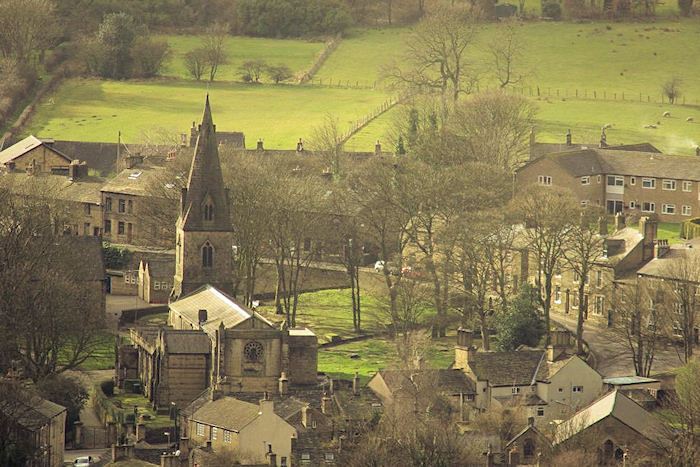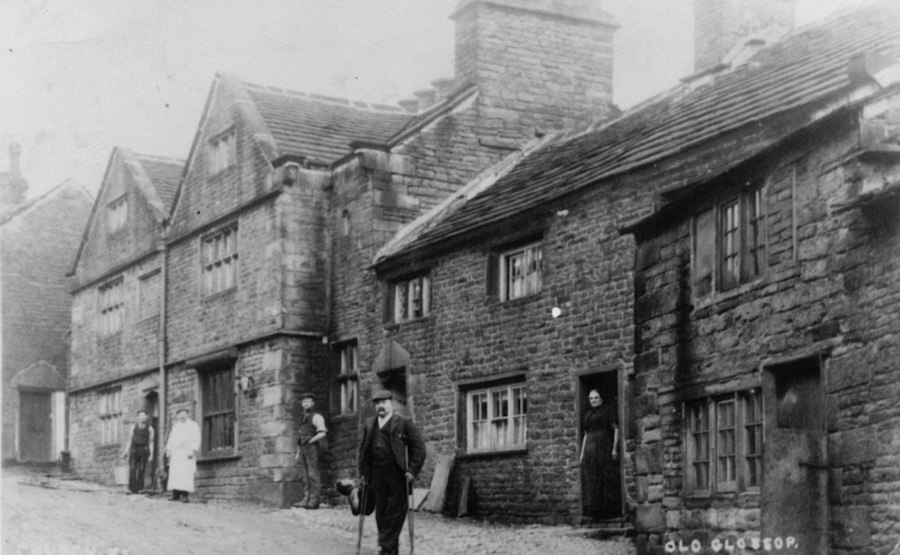 20 people plus one handsome dog joined Neil Mullineux on Monday evening for his history tour of Glossop. We met at the car park at Melandra Fort (though one needs imagination to see the fort). From here Neil explained the topography of the valleys and how this influenced the various landowners over the years, including the Romans, the Abbots of Basingwerk and latterly perhaps “more recently”, the Dukes of Norfolk and several prominent mill owners. It was a glorious summer’s evening and it was a pleasure to stand on the hillside and survey one of the gateways to the Peak District.
20 people plus one handsome dog joined Neil Mullineux on Monday evening for his history tour of Glossop. We met at the car park at Melandra Fort (though one needs imagination to see the fort). From here Neil explained the topography of the valleys and how this influenced the various landowners over the years, including the Romans, the Abbots of Basingwerk and latterly perhaps “more recently”, the Dukes of Norfolk and several prominent mill owners. It was a glorious summer’s evening and it was a pleasure to stand on the hillside and survey one of the gateways to the Peak District.
 We then moved to Old Glossop (right) which seems to have a profusion of public houses, and walked around the steep streets whilst Neil pointed out various architectural features of the houses, some of which had been built originally as mills but on a much smaller scale than those we know from Marple and Mellor. We stood by Manor Park and heard about the Howard family’s grand residence, sadly long demolished, and how several members of the Howard family from Glossop succeeded to the premier dukedom of England.
We then moved to Old Glossop (right) which seems to have a profusion of public houses, and walked around the steep streets whilst Neil pointed out various architectural features of the houses, some of which had been built originally as mills but on a much smaller scale than those we know from Marple and Mellor. We stood by Manor Park and heard about the Howard family’s grand residence, sadly long demolished, and how several members of the Howard family from Glossop succeeded to the premier dukedom of England.
Finally, we moved to what is now the town centre, also known as Howardtown, and learned how Glossop moved from having many small mills to a few very large concerns. This new, industrial scale, cotton industry was also developed by the efforts of outsiders such as John Wood (Howardtown Mills) and Francis Sumner (Wren Nest Mill) Another outsider, Partington came in 1876 and developed a paper making enterprise, in Turnlee Mill. This grew rapidly and within a decade was exporting high quality paper worldwide.
The Glossop Brook and the many smaller tributaries which fed into it and then into the Etherow, all contributed to the development of the early mills. The first steam engines arrived in the town in 1827, and from then on the larger, later mills were all steam powered.

We stood and discussed the grand facade of the original Town Hall which is now a shopping arcade and compared it to an artist’s impression of the Duke’s much grander vision. We were standing at a bus stop and when a bus drew up we could see the anticipatory gleam in the driver’s eye. Unfortunately for him it was not to be; we walked away crossing to Norfolk Square to observe the imposing Victorian buildings, including the Partington Theatre. From there we walked up to the Grade II listed railway station, built by the 13th Duke, to admire it's elegant features, including the statue of a standing lion with tail extended (right) which stands proudly over what was originally the Duke’s private entrance to the station. Neil explained the Duke’s involvement with the railway company, his insistence on extending the railway line from Dinting to Howard’s Town at his own expense but which he subsequently sold to the Sheffield, Ashton under Lyne and Manchester Railway. Today, Friends of Glossop Station are active in caring for the station which includes history displays and an art room.
A thoroughly entertaining and informative evening - many thanks to Neil.
The evening raised £60 for Christie’s, Neil’s nominated charity.
Hilary Atkinson, June 2017
More, much more, information on the history town and area can be found on the Glossop Heritage Trust website
Glossop High Street Video taken in the 1900s, below the gallery.
All photographs below, of the evening stroll, provided by David Burridge
Glossop High Street Video taken in the 1900s





















